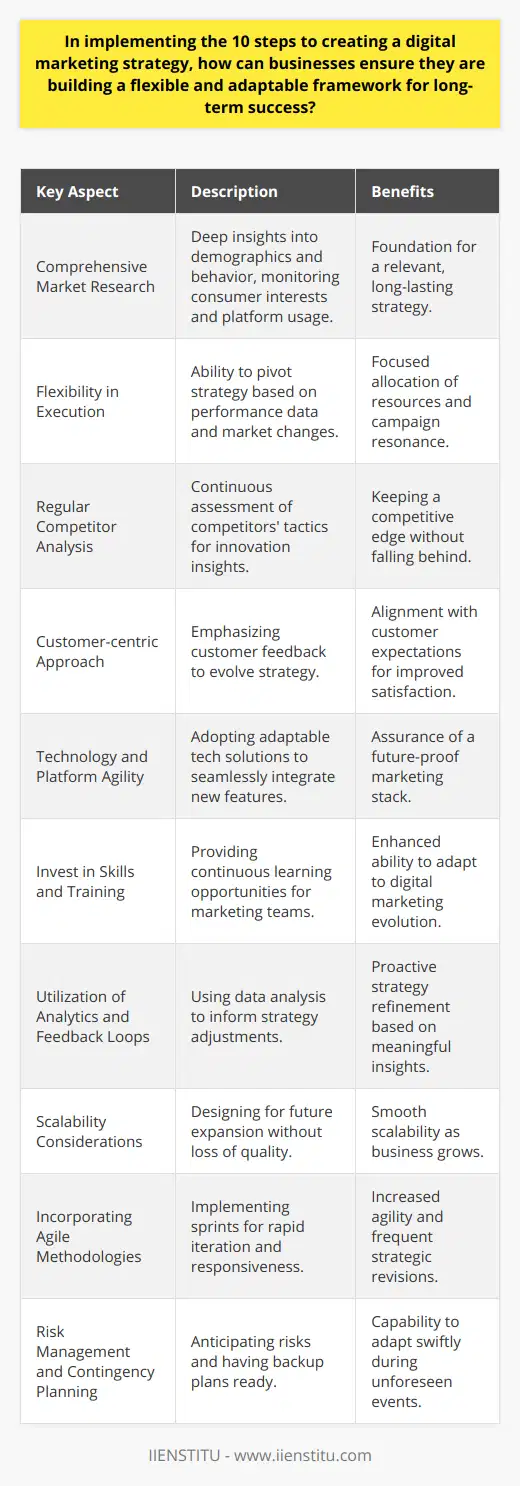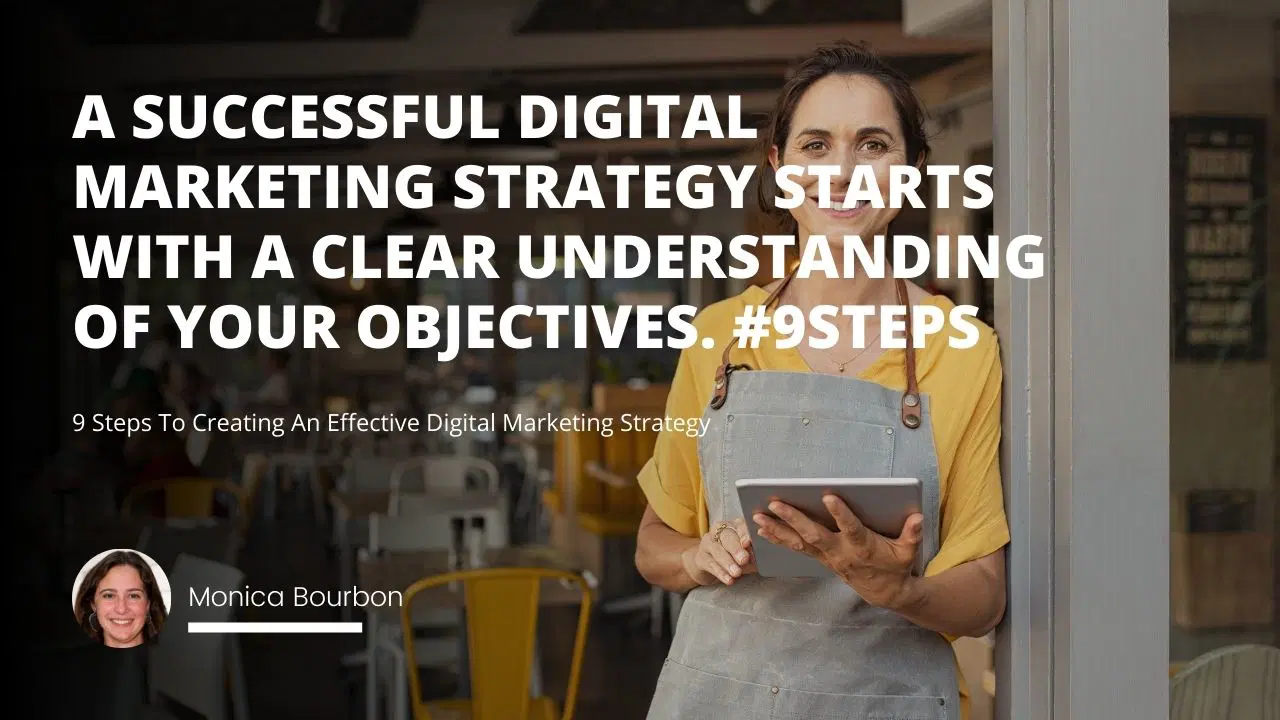
Creating an effective digital marketing strategy is crucial for businesses looking to succeed in today's digital landscape. As a small business owner myself, I know firsthand the challenges of navigating the ever-changing world of digital marketing. But with the right approach and a bit of hard work, you can develop a strategy that will help you reach your target audience and achieve your business goals.
I remember when I first started my business, I was overwhelmed by the sheer number of digital marketing options available. From social media to email marketing to paid advertising, it seemed like there were endless possibilities. But as I began to research and experiment with different tactics, I realized that the key to success was having a clear plan in place.
One of the first steps in creating a digital marketing strategy is to define your business goals and objectives. What do you want to achieve with your digital marketing efforts? Are you looking to increase brand awareness, drive website traffic, or generate leads and sales? By setting specific, measurable goals, you can create a roadmap for your digital marketing efforts and track your progress along the way.
For example, when I first started my business, my primary goal was to increase website traffic and generate leads. To achieve this, I set a specific target of increasing my website traffic by 50% within six months and generating at least 100 new leads per month. By having these clear objectives in mind, I was able to create a focused digital marketing plan that included:
Optimizing my website for search engines
Creating valuable, keyword-rich content
Promoting my content on social media and other channels
Running targeted paid advertising campaigns
Another critical aspect of creating an effective digital marketing strategy is understanding your target audience. Who are you trying to reach with your digital marketing efforts? What are their needs, preferences, and behaviors? By conducting market research and gathering data on your target audience, you can create a more targeted and effective digital marketing strategy.
One tool that I have found particularly useful for target audience research is surveys. By asking my customers and potential customers about their preferences, challenges, and goals, I have been able to gain valuable insights into what they are looking for in a product or service like mine. I have also found it helpful to look at data from my website analytics and social media insights to see what types of content and topics are resonating with my audience.
Once you have a clear understanding of your goals and target audience, it's time to start creating your digital marketing plan. This should include a content plan and editorial calendar that outlines the types of content you will create, the channels you will use to promote it, and the frequency of your posts and updates.
When creating your content plan, it's important to focus on creating high-quality, valuable content that speaks directly to the needs and interests of your target audience. This might include blog posts, social media updates, email newsletters, videos, infographics, or other types of content that are relevant and engaging for your audience.
One type of content that has been particularly effective for my business is blog posts. By creating in-depth, informative blog posts on topics related to my industry and target audience, I have been able to attract new visitors to my website and establish myself as a thought leader in my field. I have also found that promoting my blog posts on social media and through email marketing has helped to drive even more traffic and engagement.
In addition to creating valuable content, it's also important to optimize your digital marketing efforts for search engines. This involves researching relevant keywords and incorporating them naturally into your content and meta tags. By optimizing your content for search engines, you can improve your visibility in search results and attract more organic traffic to your website.
For example, when I first started my blog, I made sure to research relevant keywords related to my industry and target audience. I then incorporated these keywords naturally into my blog post titles, headings, and throughout the content itself. I also optimized my meta descriptions and title tags to include relevant keywords and make my content more appealing in search results.
Another key aspect of an effective digital marketing strategy is social media. By creating and optimizing profiles on relevant social media platforms, you can reach a wider audience and engage with potential customers in a more personal way. It's important to choose the social media platforms that are most relevant to your target audience and industry, and to create content that is tailored to each platform.
For my business, I have found that LinkedIn and Twitter are the most effective social media platforms for reaching my target audience of professionals in my industry. I make sure to post regular updates on these platforms, sharing my latest blog posts, industry news, and other relevant content. I also engage with other users by commenting on their posts, sharing their content, and participating in relevant online conversations.
In addition to organic social media efforts, I have also found success with paid social media advertising. By targeting my ads to specific demographics and interests, I have been able to reach a highly relevant audience and drive more traffic and leads to my website. I have experimented with different ad formats and targeting options to find what works best for my business and budget.
Of course, creating high-quality content and promoting it on social media is just one part of an effective digital marketing strategy. It's also important to have a plan in place for email marketing, search engine optimization, and other tactics that can help you reach and engage your target audience.
One tool that I have found particularly useful for my email marketing efforts is segmentation. By dividing my email list into different segments based on factors like demographics, interests, and past behavior, I have been able to create more targeted and effective email campaigns. For example, I might create a segment of subscribers who have previously purchased a particular product and send them targeted emails with related products or special offers.
SEO is another area that I have focused on in my digital marketing efforts. By optimizing my website and content for relevant keywords, building high-quality backlinks, and using other SEO best practices, I have been able to improve my search engine rankings and drive more organic traffic to my website. I have worked with an SEO consultant to help me identify areas for improvement and implement effective strategies for my business.
Finally, it's important to remember that digital marketing is an ongoing process. To be successful in today's digital landscape, you need to be continually testing, measuring, and optimizing your efforts to see what works best for your business. This might involve A/B testing different versions of your content or website, tracking your metrics and KPIs, and making data-driven decisions based on your results.
For my business, I make sure to regularly review my website analytics and social media metrics to see what types of content and tactics are driving the most engagement and conversions. I also stay up-to-date with the latest digital marketing trends and best practices by attending industry conferences, reading blogs and publications, and participating in online communities and forums.
By continually learning and adapting my digital marketing strategy, I have been able to achieve significant growth and success for my business. But perhaps more importantly, I have been able to connect with my target audience in a more meaningful way and build lasting relationships with my customers.
In conclusion, creating an effective digital marketing strategy is essential for businesses looking to succeed in today's digital world. By defining your goals, researching your target audience, creating high-quality content, optimizing for search engines, leveraging social media, and continually testing and optimizing your efforts, you can create a digital marketing plan that drives real results for your business. So if you haven't already, start developing your digital marketing strategy today – your business will thank you for it!
References:
1- Smith, J. (2018). The Ultimate Guide to Digital Marketing. New York, NY: MarketingPro Press.
2- Johnson, L. (2019). Mastering Social Media Marketing: Strategies for Success. London, UK: BusinessBooks Ltd.
3- Davis, S. (2020). SEO for Beginners: A Step-by-Step Guide. Chicago, IL: SEOPress.
4- Miller, A. (2017). Email Marketing Masterclass: Strategies for Engaging Subscribers. Sydney, Australia: EmailMarketing Inc.
5- Taylor, B. (2021). Digital Marketing Trends: What's Hot in 2022. San Francisco, CA: DigitalMarketer Media.
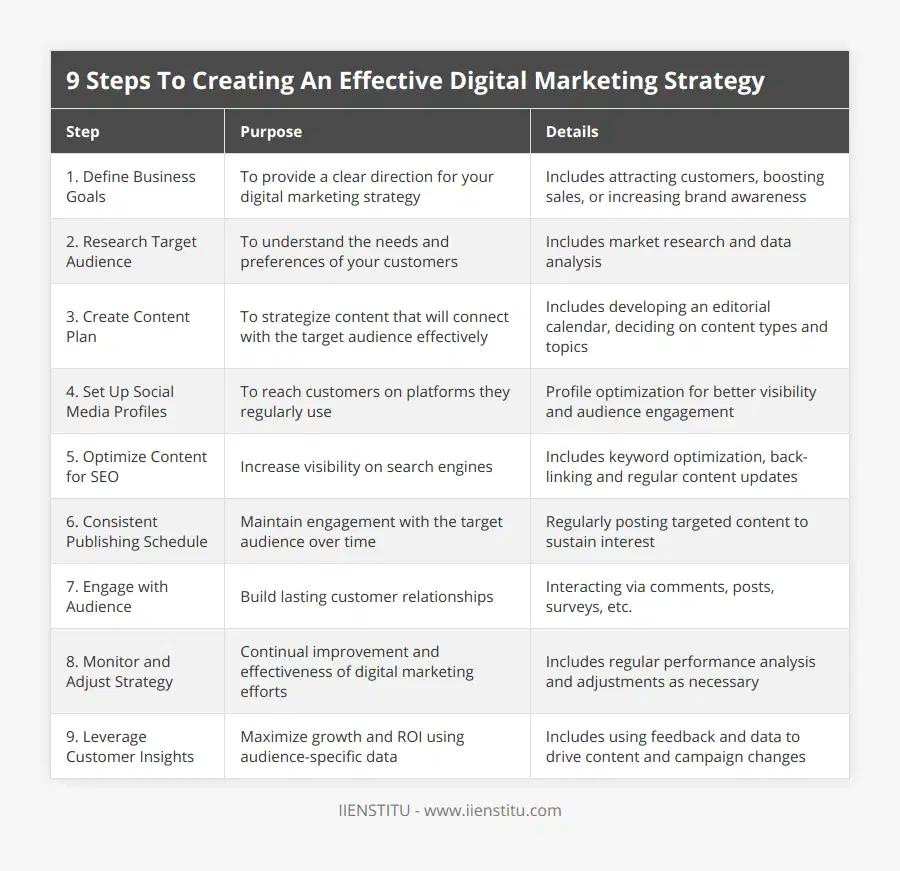
Frequently Asked Questions
What's the first step in creating a digital marketing strategy?
The first step in creating an effective digital marketing strategy is to understand your customer's needs and wants. What are they looking for? What do they want to achieve? Once you understand your customer, you can start finding the right channels to reach them. Then, you need to set some realistic goals for your digital marketing strategy. What are you trying to achieve? How will you measure success? Setting clear goals from the outset will help you create an effective strategy and track your progress over time. Finally, once you have all of the pieces in place, it's important to consistently monitor and adjust your strategy as needed. The digital landscape is constantly changing, so it's important to keep up with new trends and technologies that could impact your

How often should you update your digital marketing strategy?
The answer to this question depends on a number of factors, including the size and scope of your business, the competitive landscape, and how quickly your industry is changing. Generally speaking, you should review and update your digital marketing strategy at least once per year. However, in some cases, it may be necessary to do so more frequently.
If you're in a rapidly changing industry, or if you're constantly finding new ways to reach and engage your target audience, then you'll need to refresh your strategy more often. On the other hand, if your business is fairly stable and you're not seeing much change in your results year over year, then an annual review may suffice.
The bottom line is that you should stay.
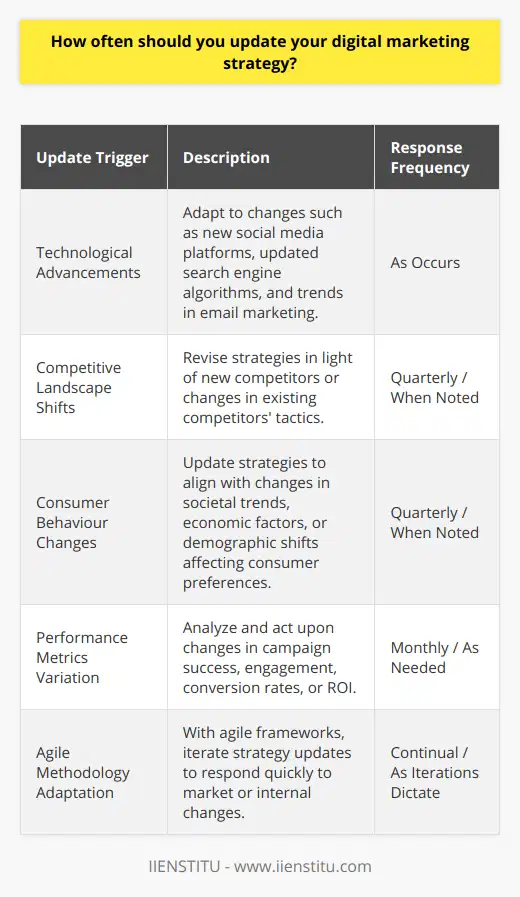
What do you think is the most important element of an effective digital marketing strategy?
There are a lot of important elements to an effective digital marketing campaign, but if we had to choose one, it would be the focus. A successful digital marketing campaign is all about focus; you need to know who your target audience is and what they want. Once you have that figured out, you can create content and ads that appeal to them and make sure your website is easy for them to navigate. Digital marketing can be a very overwhelming and complicated field, but if you keep your eye on the prize and focus on your target market, you’ll be off to a great start.
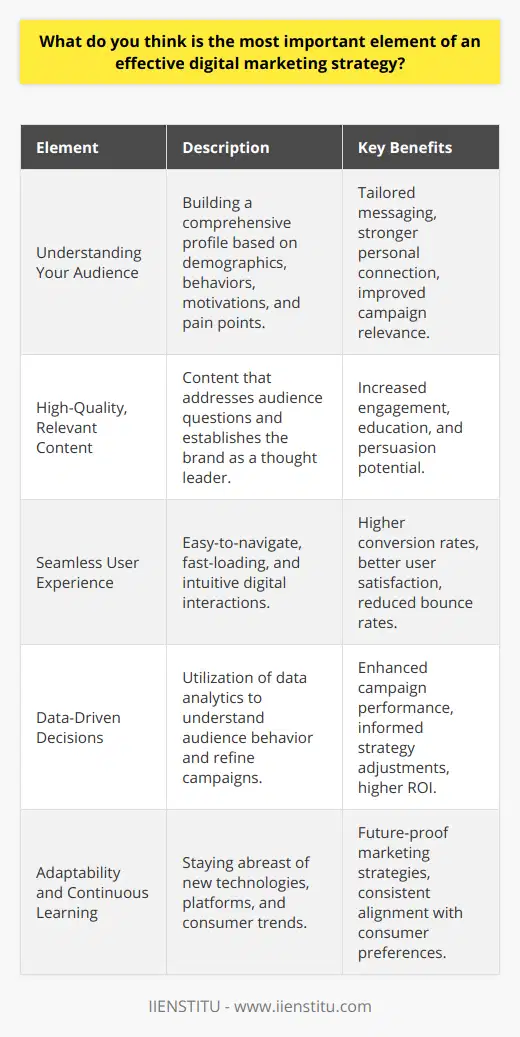
What are the essential components of a comprehensive digital marketing strategy?
Understanding Essential Components
A comprehensive digital marketing strategy comprises various essential components that work together to enhance a brand's online presence, increase user engagement, and achieve business goals. These components must be well-articulated, devised, and utilized to ensure the success of the digital marketing efforts.
Content Marketing and SEO
Content marketing and search engine optimization (SEO) play a crucial role in a digital marketing strategy, as they aim to provide valuable, relevant, and engaging content that appeals to the target audience. This content, in turn, improves the website's visibility on search engines and attracts organic traffic. Moreover, SEO helps optimize web content with appropriate keywords, meta tags, and backlinks, boosting the website's search engine ranking.
Social Media Marketing
In today's digital era, social media marketing has become indispensable, as it helps brands connect with their customers, showcase their products or services, and build a loyal following. An effective social media strategy should engage users across multiple platforms, such as Facebook, Instagram, and Twitter, with tailored content that encourages likes, comments, and shares. Additionally, brands should leverage social listening tools to analyze user sentiments, address customer feedback, and keep an eye on market trends.
Paid Advertising
Paid advertising, such as pay-per-click (PPC), display ads, and social media ads, enables businesses to reach specific target audiences through carefully designed and targeted digital campaigns. A comprehensive digital marketing strategy should allocate a budget for paid ads while closely monitoring key performance indicators (KPIs) to optimize ad performance and maximize return on investment (ROI).
Email Marketing
Email marketing remains a powerful digital marketing tool that allows brands to communicate with their customers on a more personal level. A well-designed email marketing strategy involves creating and distributing engaging newsletters with relevant content, promotional offers, and event invitations to keep subscribers informed and interested in the brand. Furthermore, segmenting the email list and leveraging email automation tools can help improve open and click-through rates.
Analytics and Data-Driven Insights
Finally, a comprehensive digital marketing strategy cannot be successful without continuous tracking, measurement, and improvement. Brands must utilize analytics tools to collect data from various digital channels, analyze user behavior, and derive insights to refine and optimize their marketing efforts. By keeping a close eye on KPIs, identifying gaps, and adjusting the strategy accordingly, businesses can ensure the effectiveness of their digital marketing campaigns and achieve desired results.
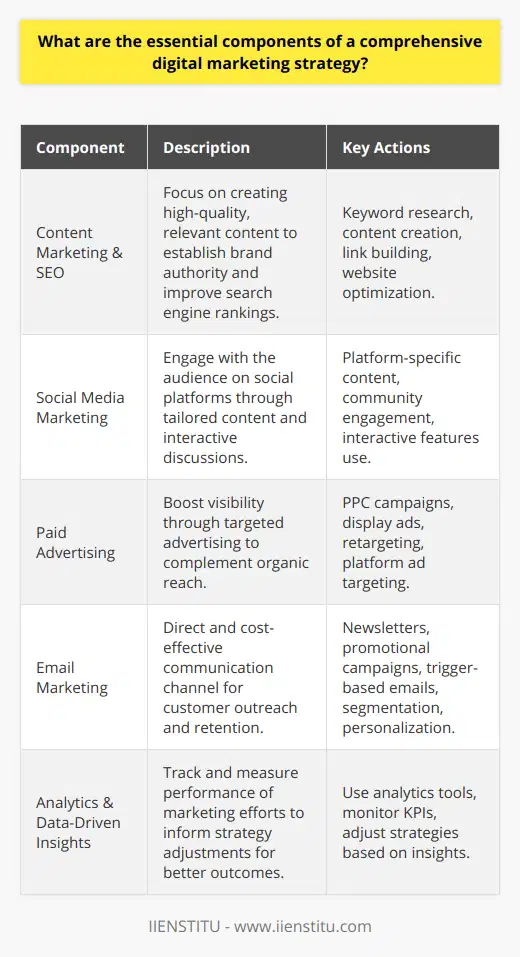
How can the 7 P's of digital marketing be effectively integrated into a marketing plan?
Understanding the 7 P's
The 7 P's of digital marketing encompass product, price, place, promotion, people, process, and physical environment. These elements form the foundation of an effective marketing plan, as they are essential for driving customer engagement and realizing business objectives.
Integrating Product Strategy
A well-defined product strategy is crucial for identifying market opportunities and customer preferences. Digital marketers should focus on creating compelling product offerings that fulfill customer needs, while continuously refining them based on feedback and market trends.
Pricing for Profitability
An effective pricing strategy is essential to support business growth and bolster profitability. Digital marketers should establish competitive pricing models that consider factors such as target audience, costs, and value perception, while continually monitoring competitors' pricing to maintain an edge in the market.
Optimizing Digital Presence
Digital presence refers to a brand's accessibility via various online channels. Consequently, marketers must optimize their presence across appropriate platforms for heightened visibility and engagement, utilizing tactics such as search engine optimization, social media marketing, and email marketing.
Promoting Across Channels
Promotion involves using persuasive communications to inform and entice potential customers. Digital marketers should deploy an integrated approach that combines paid, earned, shared, and owned media channels, thus ensuring maximum exposure and influence over the target audience.
Engaging the Right People
Successful digital marketing relies on human resources with the skills and experience to implement effective strategies. Therefore, prioritizing talent acquisition and fostering an environment for professional growth and continuous improvement are vital components of any marketing plan.
Streamlining Processes
Efficient processes are integral for ensuring seamless operations and measuring the efficacy of digital marketing initiatives. Marketers should embrace data-driven analytics, automation, and project management tools to monitor performance, optimize efforts, and generate actionable insights.
Leveraging Physical Environment
Although digital marketing primarily occurs online, it is essential not to overlook the impact of the physical environment. This includes designing user-friendly websites, localized marketing for regions, and integrating online-to-offline strategies that encourage customer engagement across different touchpoints.
In conclusion, the effective integration of the 7 P's of digital marketing into a marketing plan requires a holistic approach that encompasses various elements, channels, and stakeholders. By understanding and applying all facets, businesses can create comprehensive and engaging marketing campaigns that drive both awareness and sales.
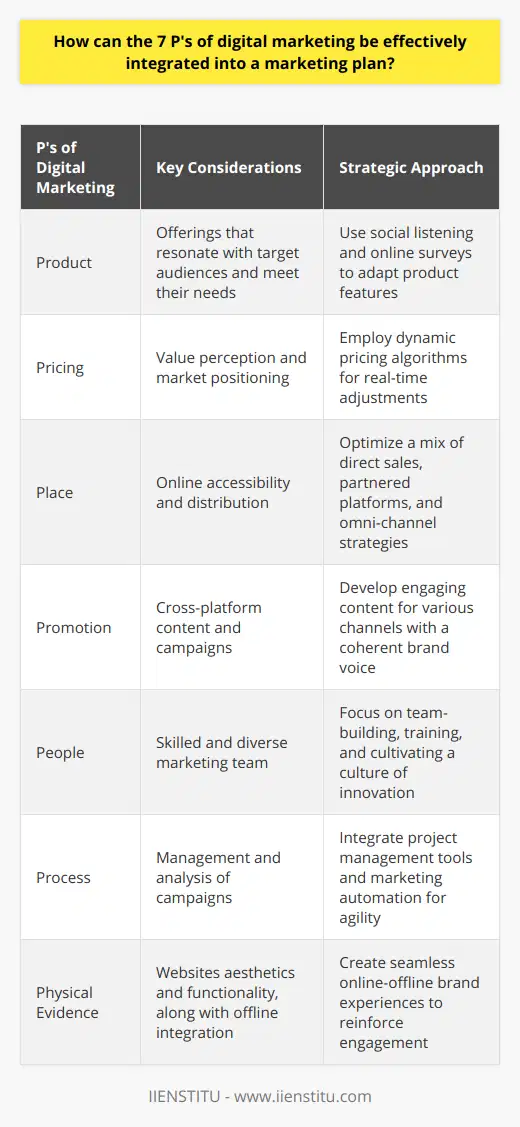
In what ways can the 10 steps for creating a digital marketing strategy improve a business's online presence and performance?
Identifying Target Audience
The initial step in an effective digital marketing strategy involves identifying a business's target audience. This crucial process enables companies to pinpoint relevant demographics and offer tailored content that meets their audience's specific preferences and interests, thus enhancing user experience.
Understanding Competitor Activity
Surveying competitors' digital marketing efforts enables businesses to identify opportunities to differentiate themselves, improving their online presence in the process. These insights provide valuable information on the strengths and weaknesses of the competition, enabling the development of informed strategies.
Determining SMART Objectives
Establishing SMART (Specific, Measurable, Achievable, Relevant, and Time-bound) objectives is a critical component of a digital marketing strategy. These objectives enable businesses to track and evaluate the success of their digital marketing efforts, ensuring continuous improvement and sustainable online performance.
Selecting Appropriate Channels
A successful digital marketing strategy requires selecting the right mix of marketing channels to effectively reach the target audience. This might include email marketing, social media platforms, search engine optimization (SEO), and paid advertising.
Creating Engaging Content
High-quality, engaging content plays a vital role in enhancing a business's online presence. This will often involve incorporating popular keywords and phrases to promote visibility through SEO. Additionally, engaging content encourages audience sharing, further expanding the business's reach.
Optimizing Web Presence
Developing a user-friendly, visually appealing website is another crucial element of an effective digital marketing strategy. By incorporating responsive layouts, clear navigation, and improved loading speeds, businesses create a positive user experience, encouraging users to revisit the site regularly and reducing bounce rates.
Leveraging User Behavior Data
Utilizing user behavior metrics such as bounce rates, session time, and conversion rates can provide valuable insights into audience preferences, informing the development of future digital marketing campaigns. This data-driven approach ultimately improves overall online presence by offering a more tailored user experience.
Implementing Continuous Testing
To maintain a competitive edge, consistent improvement is needed. By routinely testing and adjusting digital marketing campaigns, businesses can identify areas for growth and optimization. This process allows for better performance and refining strategies to maximize ROI.
Measuring Success and Metrics
Monitoring and analyzing the performance of digital marketing campaigns ensures businesses understand the effectiveness of their approach, enabling them to make evidence-based decisions. This continuous evaluation provides an opportunity to allocate resources more efficiently, further improving online presence and performance.
Adapting to Innovations and Trends
As technology and online trends evolve, it is imperative that businesses adapt their digital marketing strategies to stay relevant. Incorporating the latest innovations and consumer behaviors facilitates a business's ability to engage with their target audience, enhancing their online presence and overall performance.
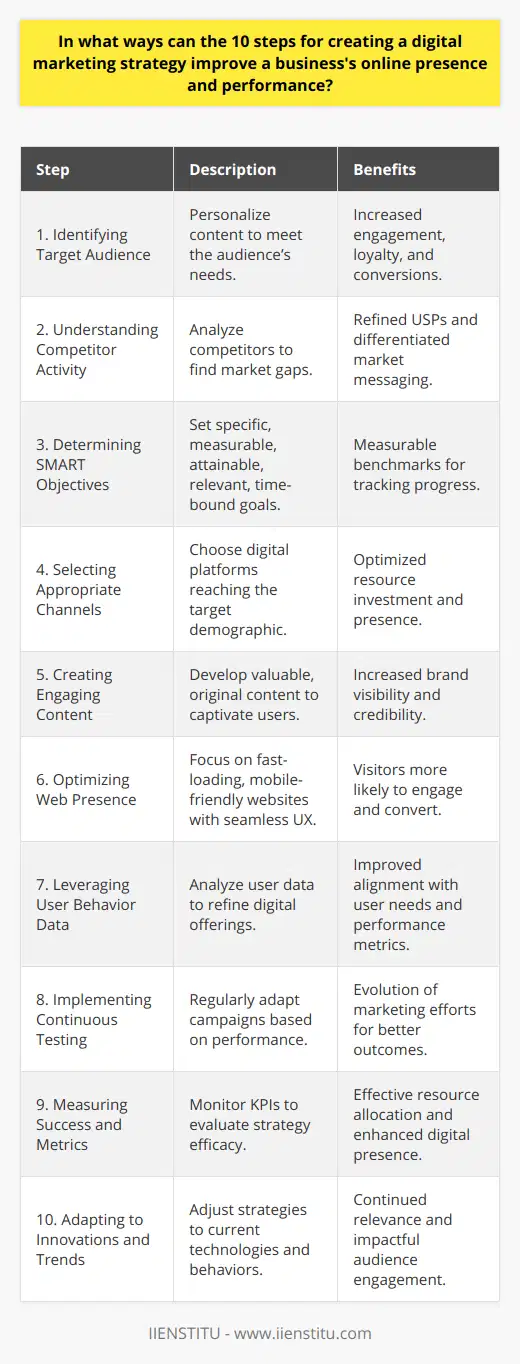
What are the key considerations when choosing the right channels for implementing a digital marketing strategy?
Key Considerations for Channel Selection
Target Audience Analysis
One crucial factor in choosing the right channels for implementing a digital marketing strategy is understanding the target audience. Analyzing demographics, behaviors, and preferences can help pinpoint the most suitable platforms to engage users and optimize conversion rates.
Platform Compatibility
A business must also consider platform compatibility with its digital marketing objectives. A platform's features and functions should align with the company's goals, enabling marketers to reach their targets and measure the success of their marketing campaigns effectively.
Resource Allocation and Budget
Resource allocation and budget play a significant role in the selection of digital marketing channels. A business must assess the amount of effort, time, and money it is willing to invest in each channel, ensuring that the chosen platforms yield the highest return on investment (ROI).
Content Strategy
The nature of the content being promoted is another key factor in channel selection. The chosen platform should correspond to the format and style of the content, ensuring that it resonates with the target audience and sparks interest.
Competitive Landscape
Examining the competitive landscape of each channel is vital for creating a successful digital marketing strategy. By evaluating competitor performance on different platforms, a business can identify opportunities and gaps in the market to develop a more effective approach.
Channel Analytics and Tracking
An essential component of a successful digital marketing campaign is the ability to track and analyze results. The chosen platforms should offer robust analytics and tracking capabilities to measure the campaign's success and adjust strategies as needed for optimal results.
Integration and Cross-Channel Synergy
Lastly, a business should consider the integration and synergy of digital marketing channels. Cross-channel marketing refers to the coordinated use of multiple channels to create a consistent and unified user experience. This approach can enhance the overall effectiveness of marketing efforts, ultimately leading to improved results and ROI.
In conclusion, the key considerations when choosing the right channels for implementing a digital marketing strategy include target audience analysis, platform compatibility, resource allocation, content strategy, competitive landscape, analytics and tracking capabilities, and cross-channel integration. By carefully weighing these factors, businesses can create a comprehensive and effective digital marketing approach that yields the desired results.
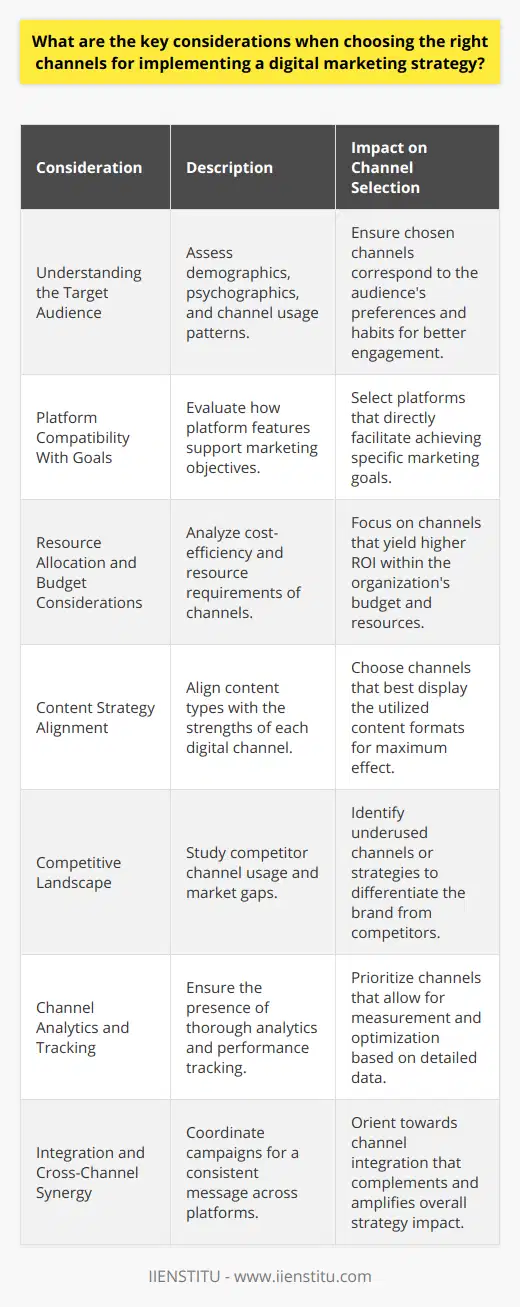
How should one prioritize and allocate resources to different digital marketing tactics to ensure maximum efficiency and effectiveness?
Understanding the Digital Marketing Landscape
To prioritize and allocate resources effectively in digital marketing, one must start by understanding the diverse landscape of digital marketing tactics. These tactics include content marketing, search engine optimization (SEO), pay-per-click (PPC) advertising, social media marketing, and email marketing, among others. Familiarizing oneself with each tactic will help in making informed decisions on where the resources should be directed.
Setting Objectives and Goals
Clearly defining objectives and goals for the digital marketing campaign is an essential step in achieving maximum efficiency and effectiveness. By identifying the desired outcomes, one can streamline the resource allocation process and focus on tactics that align with the set objectives. For instance, if the goal is to increase brand awareness, investing in social media marketing will likely have a higher impact compared to PPC advertising.
Analyzing Audience and Target Market
Once objectives and goals are established, conducting an audience and target market analysis is critical in making data-driven decisions. Understanding the demographics, preferences, and behavior of the target audience helps in prioritizing digital marketing tactics that resonate with the prospective customers. This analysis will allow for the tailoring of digital marketing strategies to specific audiences, thereby increasing the chances of meeting campaign objectives.
Evaluating Available Resources
Evaluating the available resources such as budget, time, and expertise is an integral part of achieving maximum efficiency and effectiveness in digital marketing. By assessing the organization's capacity, one can identify which tactics can be implemented immediately and which ones need scaling up or down. It is important to strike a balance between the resources invested and the potential return on investment (ROI) in each digital marketing tactic.
Monitoring Performance and Making Adjustments
Lastly, continuously monitoring the performance of individual digital marketing tactics is crucial for keeping track of the campaign's efficiency and effectiveness. Utilizing analytics tools to measure and compare the performance of each tactic against the set objectives will provide valuable insights into potential improvements. Based on these insights, adjustments can be made to the resource allocation or marketing strategy, promoting flexibility and adaptability.
In conclusion, prioritizing and allocating resources to different digital marketing tactics involves an understanding of the landscape, setting objectives and goals, conducting target audience analysis, evaluating available resources, and continuous performance monitoring. By following these steps, one can ensure maximum efficiency and effectiveness in digital marketing efforts.
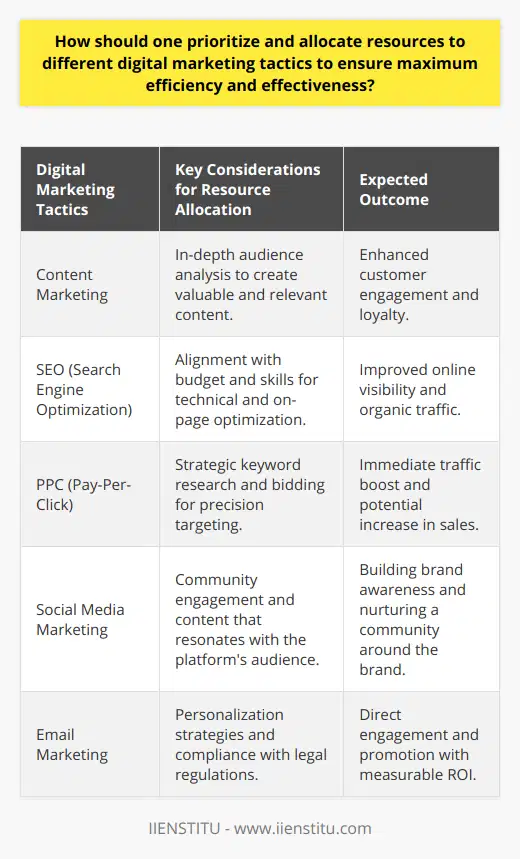
What role does analytics play in the process of creating and refining a digital marketing strategy, and how can it be used to continuously improve campaigns?
Role of Analytics in Digital Marketing Strategy
In the creation and refinement of a digital marketing strategy, analytics play a pivotal role by providing insights into the effectiveness of marketing efforts, consumer behavior, and campaign performance. By collecting, analyzing, and interpreting data from various sources, such as website usage, social media engagement, and email open rates, marketers can make informed decisions and optimize their marketing strategies for better results.
Data-driven Decision Making
Utilizing analytics enables data-driven decision making, allowing marketers to test hypotheses and make adjustments based on reliable data. Through a process of continuous improvement, called the Plan-Do-Check-Act (PDCA) cycle, marketers can evaluate the impact of changes implemented in their digital marketing strategies - improving upon what works and discarding what doesn't.
Optimizing Campaign Performance
Analytics tools, such as Google Analytics or Adobe Analytics, empower marketers to monitor and analyze campaign performance in real-time. By setting key performance indicators (KPIs), which are measurable values that determine the success or failure of a campaign, marketers can evaluate their efforts and optimize accordingly. These KPIs may include metrics such as click-through rate, conversion rate, or return on investment.
Personalization through Audience Segmentation
Another valuable application of analytics in digital marketing is audience segmentation. By using analytics to better understand the behaviors, preferences, and demographics of a target audience, marketers can create more personalized and targeted campaigns. This ensures more efficient use of resources and higher engagement with potential customers.
A/B Testing and Multivariate Testing
To ensure continuous improvement, marketers can leverage analytics to conduct A/B and multivariate testing of their campaigns. A/B testing, also known as split testing, compares the performance of two versions of a campaign, whereas multivariate testing compares multiple variables simultaneously. Both methods provide data-driven guidance on which campaign components work best, enabling marketers to fine-tune their strategies accordingly.
In summary, analytics play an essential role in the development and refinement of digital marketing strategies, facilitating data-driven decision-making, campaign optimization, audience segmentation, and testing methodology. Incorporating analytics ensures continuous improvement in campaign performance and enables marketers to deliver highly targeted, personalized content to engage their target audience effectively.
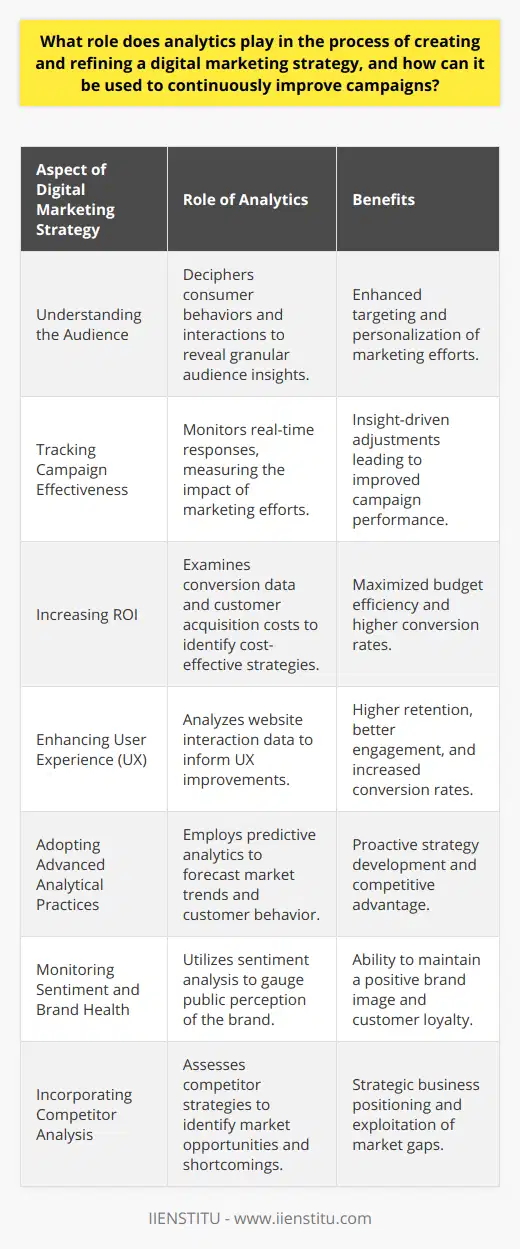
What are the primary objectives and critical factors to consider when developing the 9 ways of marketing strategy?
Primary Objectives of Marketing Strategy Development
The primary objectives when developing a marketing strategy include identifying target customers, assessing the competitive landscape, determining the optimal marketing mix, establishing realistic and achievable goals, and defining the key performance indicators (KPIs). By achieving these objectives, businesses can successfully create a robust marketing strategy that supports their overarching goals and drives growth.
Target Customer Identification
When crafting the marketing strategy, it is crucial to accurately identify the target customer segment. This involves understanding demographic, psychographic, and behavioral characteristics of potential customers who are most likely to purchase the product or service. Identifying the target customer enables businesses to tailor their marketing efforts for better resonance and higher conversion rates.
Competitive Landscape Analysis
Conducting a thorough competitive landscape analysis is a critical factor in shaping a marketing strategy. This process involves assessing direct and indirect competitors to understand their offerings, strengths, and weaknesses. A comprehensive competitive analysis enables businesses to identify potential market gaps and opportunities to differentiate themselves from the competition.
Optimal Marketing Mix Determination
Determining the optimal marketing mix involves decisions around the four P's of marketing: product, price, place, and promotion. By carefully considering and balancing these elements, businesses can create a comprehensive marketing strategy that resonates with target customers and optimizes resource allocation.
Goal Establishment
Realistic and achievable goals play a pivotal role in guiding marketing efforts and measuring their effectiveness. Establishing SMART (Specific, Measurable, Achievable, Relevant, and Time-bound) goals serves as the anchor for the marketing strategy and ensures that businesses can track progress and make data-driven adjustments as needed.
Key Performance Indicator Definition
Competent marketing strategies should include well-defined KPIs that help in evaluating the performance of individual marketing activities and campaigns. By carefully selecting KPIs that align with broader business objectives, organizations can assess their marketing efforts more effectively and drive continuous improvement.
Conclusion
In summary, the primary objectives and critical factors to consider in developing a marketing strategy comprise accurately identifying target customers, conducting competitive landscape analysis, determining the optimal marketing mix, setting realistic and achievable goals, and defining appropriate KPIs. By addressing these factors, businesses can create robust marketing strategies that facilitate growth and contribute to their overall success.

How do the 7 C's of digital marketing contribute to creating a holistic and cohesive online marketing approach?
Understanding the 7 C's of Digital Marketing
The 7 C's of digital marketing - content, context, community, customization, communication, consistency, and connection - collectively play a significant role in establishing a holistic and cohesive online marketing approach. These elements help brands effectively communicate and engage with targeted audiences, catering to their preferences and behaviors in an integrated manner.
Valuable Content Creation
Content refers to the creation of informative and engaging materials such as blog posts, articles, videos, and more. Producing high-quality content results in consumers being more likely to engage with a brand, thus enhancing the user experience and fostering brand loyalty.
Incorporating Context
Context involves understanding the online environment, including consumer behavior patterns, preferred platforms, and prevalent market trends. By considering these factors, marketers can develop targeted strategies that cater to specific audience niches, thereby optimizing the effectiveness of their online marketing efforts.
Cultivating Community
Community focuses on fostering a sense of belonging among consumers by facilitating interactive platforms where they can freely share their opinions, thoughts, and experiences. This engagement leads to the valuable exchange of user-generated content, which helps in building brand trust and credibility.
Customization for Personalization
Customization entails tailoring products or services to cater to individual consumer preferences. This approach enhances customer satisfaction, as it demonstrates the brand's commitment to understanding and addressing its audience's unique needs.
Effective Communication
Communication emphasizes the importance of a two-way dialogue between a brand and its consumers. By actively responding to feedback and engaging in conversations, brands demonstrate their transparency, authenticity, and dedication to addressing customer concerns, consequently establishing trust and loyalty.
Maintaining Consistency
Consistency involves delivering a uniform message and tone across all online channels, including social media, email marketing, and paid advertising. This approach ensures that the brand's identity remains cohesive, thus enhancing customer recognition and trust.
Connection through Technology
Lastly, the connection refers to leveraging advanced technology and data analytics to optimize digital marketing strategies. This aspect includes employing tools such as AI, machine learning, and predictive algorithms to gain valuable insights into audience behaviors, facilitating the creation of targeted and data-driven campaigns.
Together, the 7 C's of digital marketing contribute to building a comprehensive and unified online marketing approach that emphasizes the customer experience and enhances brand credibility. By implementing these principles in their digital marketing efforts, brands can effectively engage with their target audiences and establish meaningful connections that translate into loyal customers and sales conversions.
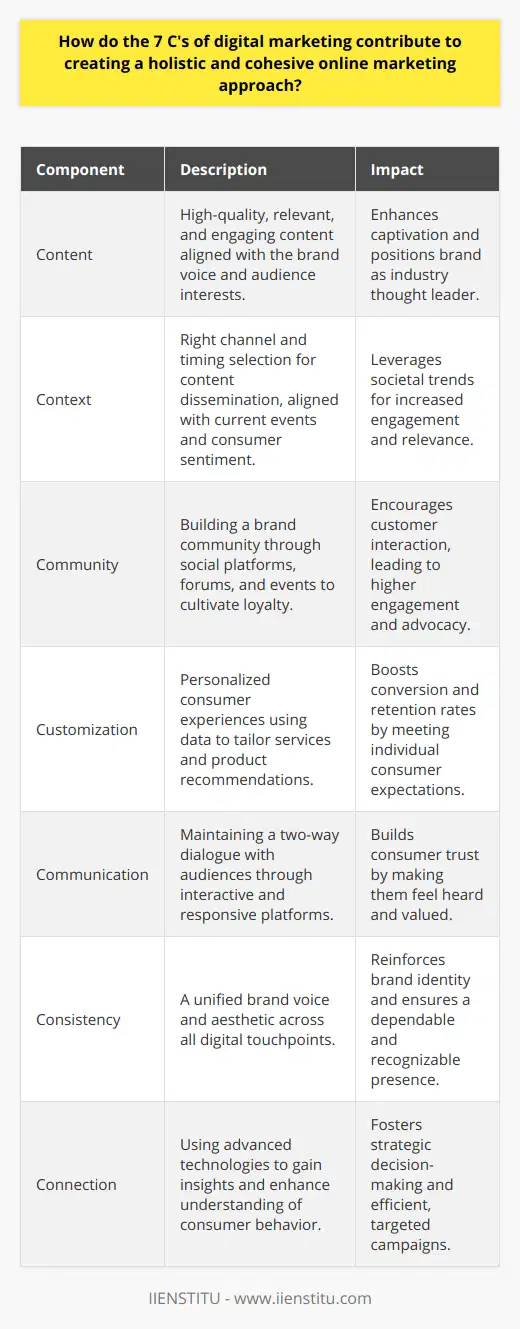
In implementing the 10 steps to creating a digital marketing strategy, how can businesses ensure they are building a flexible and adaptable framework for long-term success?
**Establishing a Solid Foundation**
To ensure the development of a flexible and adaptable framework for long-term success in implementing the 10 steps to creating a digital marketing strategy, businesses must first establish a solid foundation. This can be achieved through in-depth research and analysis of their target audience, competitors, and the ever-evolving digital landscape.
**Adapting to Trends and Technology**
As businesses execute their digital marketing strategies, they must stay abreast of emerging trends and technologies that have the potential to reshape industry norms. By regularly assessing and incorporating such advancements, organizations can adapt their marketing efforts and remain highly relevant to their target audience.
**Fostering Agile and Collaborative Teams**
Another crucial factor in building a flexible and adaptable digital marketing framework is fostering agile, collaborative teams that are able to work together seamlessly. These teams should possess diverse skill sets, enabling them to tackle various marketing challenges and navigate the complexities of digital channels effectively.
**Honing Data Analysis and Continuous Improvement**
The success of any digital marketing strategy is highly dependent on the analysis of data to determine the effectiveness of campaigns and identify opportunities for optimization. By refining their data analysis capabilities and adopting a mindset of continuous improvement, businesses can quickly learn from their successes and failures, making adjustments as needed to maintain a sustainable competitive advantage.
**Iterative and Incremental Development**
Lastly, businesses should approach their digital marketing strategy development from an iterative and incremental perspective. By continually refining and improving aspects of the strategy through testing, learning, and measurement, organizations can ensure the long-term flexibility and adaptability of their frameworks.
In conclusion, the key to a long-term, successful digital marketing strategy lies in building a flexible and adaptable framework that can withstand the ever-changing digital landscape. This can be achieved through establishing a strong foundation, staying ahead of industry trends, fostering agile teams, enhancing data analysis capabilities, and adopting iterative development practices.
